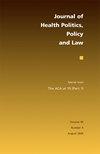Introduction to "Subnational COVID-19 Politics and Policy".
IF 3.3
3区 医学
Q1 HEALTH CARE SCIENCES & SERVICES
引用次数: 3
Abstract
This special section of JHPPL emerged as a response to a call for rigorous empirical analyses related to the politics of the COVID-19 pandemic, both in the United States and from international and comparative perspectives. Many of the cross-nationally comparative submissions we received also employ subnational comparisons, and the three articles presented here are, in different ways, exemplars of the subnational turn in comparative politics research (Snyder 2001). All of these articles use subnational comparative analysis to examine policy making, implementation, and outcomes where it actually happens: at the local level, in subnational states or regions. One reason scholars may choose to examine subnational units is to generate a larger sample size from which to draw inferences, while also controlling for confounders attributable to the national-level context. But the focus on the subnational level in these pieces does not serve only to amplify the N. Subnational comparative research can do more, as these articles show. Each of these pieces also combats “methodological nationalism” (the tendency to, often mistakenly, view the nation-state as the natural unit of observation and analysis) by examining how attributes specific to substate rather than national-level units—for example, the degree or type of decentralization, the level of (in)dependence of subnational policy and political actors from the center, the local epidemiologic context—affect policies and outcomes. Paul F. Testa, Richard Snyder, Eva Rios, Eduardo Moncada, Agustina Giraudy, and Cyril Bennouna leverage the subnational variation in when government restrictions on movement were introduced to understand“地方2019冠状病毒病政治与政策”导言。
本文章由计算机程序翻译,如有差异,请以英文原文为准。
求助全文
约1分钟内获得全文
求助全文
来源期刊
CiteScore
7.30
自引率
7.10%
发文量
46
审稿时长
>12 weeks
期刊介绍:
A leading journal in its field, and the primary source of communication across the many disciplines it serves, the Journal of Health Politics, Policy and Law focuses on the initiation, formulation, and implementation of health policy and analyzes the relations between government and health—past, present, and future.

 求助内容:
求助内容: 应助结果提醒方式:
应助结果提醒方式:


